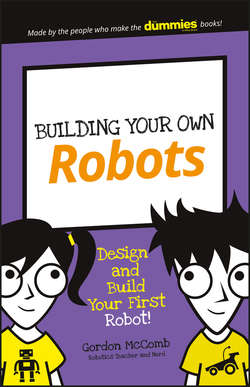Читать книгу Building Your Own Robots - McComb Gordon - Страница 3
На сайте Литреса книга снята с продажи.
PROJECT 1
MAKE A BRUSHBOT, FAST AND EASY!
ОглавлениеNOT ALL ROBOTS ROLL ON WHEELS OR WALK ON LEGS. Some of them look like centipedes and slither on the ground. Others fly in the air on their own. And a few even shake and shimmy across the floor on hundreds of tiny tentacles.
Wait … shake? Shimmy? Tiny tentacles? You bet! Introducing the brushbot, a battery operated robotic creature that’s both super-fun and easy to build.
The brushbot isn’t a new idea, and you may even have seen one in action in a YouTube video. But not all brushbots are alike. The plans I detail in this project take less than 15 minutes to complete, require no soldering, and cost less than a hamburger lunch.
Robot building doesn’t get much easier than this!
UNDERSTANDING WHAT MAKES A ROBOT
To understand how to make your own robot, you first need to know the basic parts that go into all robots.
Robots are created out of different subsystems. These include power, brains, sensors, and movement. The subsystems work together to create the finished robot. Not every robot has all subsystems. Some specialty robots lack one or more of these subsystems or have additional ones not shown here. That’s okay … they’re still robots.
For example, many combat robots, like those in the TV show Robot Wars, are operated by a human via remote control. The robot may not have an onboard brain. Other robots may not have any parts that move. Instead, they might interact with humans using a video camera and computer display.
The brushbot project contains only a few of the subsystems found in robots – namely, just power and movement. Additional robot subsystems are shown in other projects in this book.
BUILDING YOUR FIRST ROBOT: MAKE A BRUSHBOT “WALKING” ROBOT
The brushbot consists of just a few parts: A vibrating “engine,” a battery to power the engine, and a small brush that provides hundreds of teeny, wobbly “legs.”
The vibrating engine is just a fancy term for a toy motor that has an off-centered weight attached to its shaft. The weight is on crooked, so when the motor turns, the imbalance causes everything to shake. The motor vibrates. When it’s attached to a robot, the vibration literally makes the bot bounce up and down.
Конец ознакомительного фрагмента. Купить книгу
